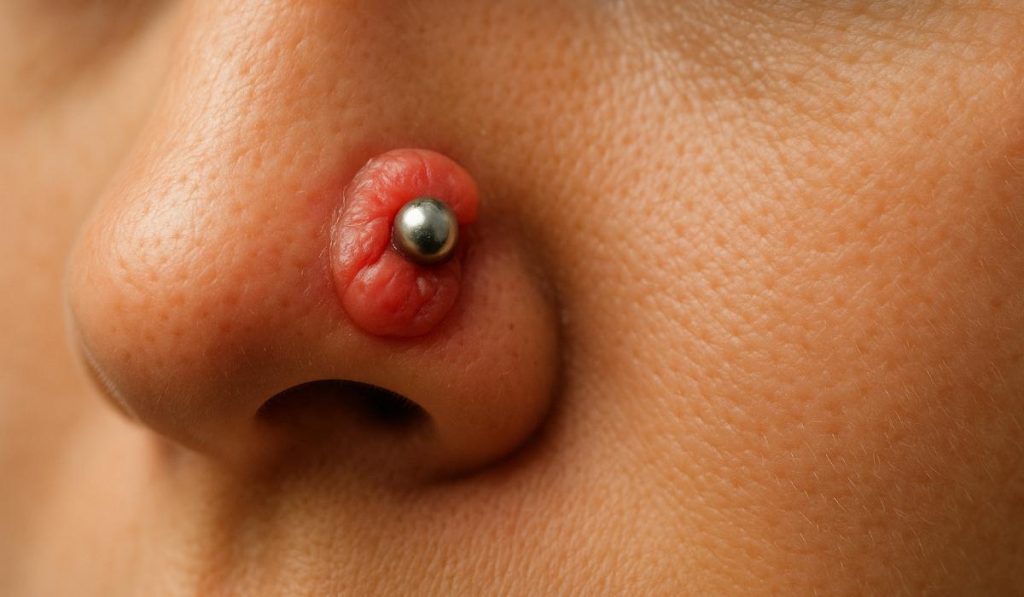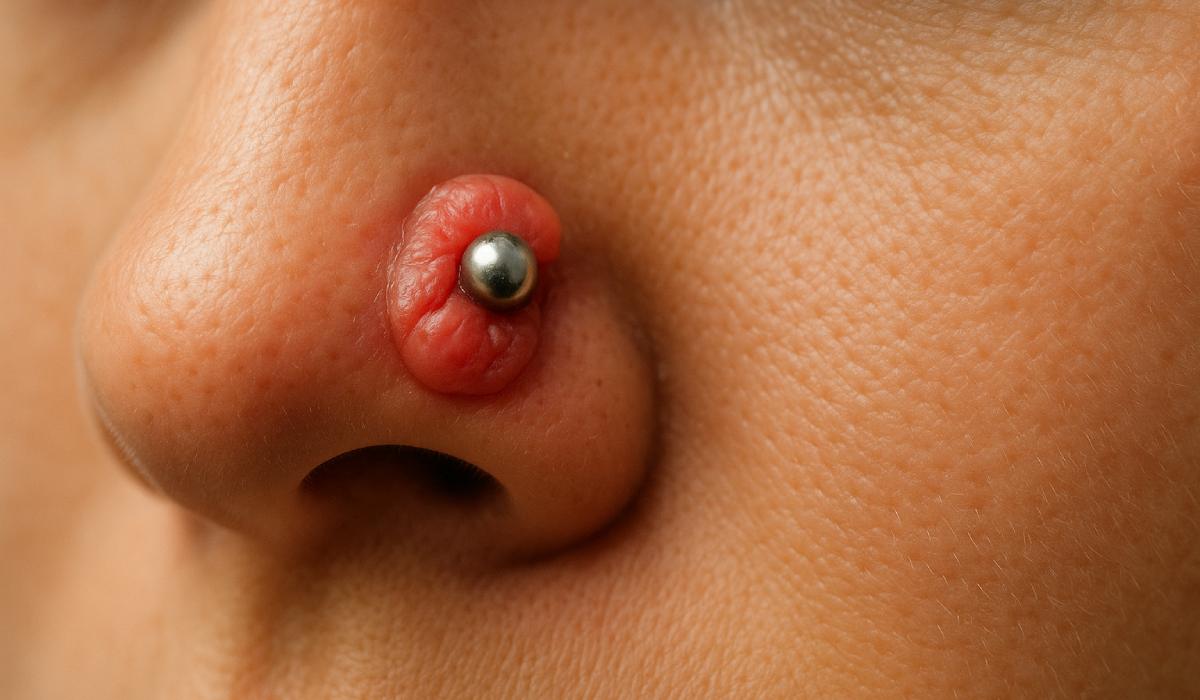
Keloid Nose Piercing
You finally get your dream nose piercing. It’s shiny, chic, and totally you. But then—bam!—a weird, puffy bump pops up, and no matter what you do, it seems to get angrier and bigger. Sound familiar?
This, my friends, might not be “just irritation.” It could be a keloid, and trust me, I’ve seen them turn confident pierces into anxious messes. As someone who’s spent years in the piercing scene and chatted with countless clients across the US, I can tell you this: keloids are tricky but not unbeatable.
So let me break it down for you. Here’s how to stop them from ruining your vibe and what to do if one shows up uninvited.
TL;DR: Quick Tips You Need to Know
- Keloids are overgrown scars, not simple bumps—know the difference early.
- Prevention is queen: experienced piercer + high-quality jewelry + zero fidgeting.
- Treatments exist: silicone sheets, steroid shots, even lasers—no one-size-fits-all.
- My holistic hacks: stress management and smart supplements really can help.
- Act early for the best results—your future nose-self will thank you.
What Is a Keloid Anyway?
Okay, let’s clear this up: a keloid is not the same as the small red bumps that sometimes show up during healing. Those little guys often go away with saline sprays and TLC.
A keloid, though? It’s like your skin’s collagen machine went into overdrive. Instead of stopping when it should, your body keeps laying down more and more scar tissue, creating a raised, rubbery mass that spills past the original piercing site.
Here’s what I tell my clients to watch for:
- Texture: feels firm, sometimes itchy
- Growth: keeps getting bigger over weeks or months
- Color: red, brownish, or even shiny pink
If this sounds like what you’re seeing, it’s time to shift gears.
Why Do Some People Get Keloids?
Let’s be real: keloids are one of skin’s great mysteries. Some people can pierce their nose five times and never get a bump, while others end up with a keloid after one tiny stud.
Here’s the kicker—not everyone will get a keloid, but some folks are genetically wired for them. In the US, I see them more often in people with:
- Darker skin tones (Fitzpatrick types IV–VI) – Studies show melanin-rich skin is more prone to keloid formation due to unique collagen activity.
- A family history of keloids – If Mom, Dad, or Grandma gets them, you might too.
- Multiple piercings in the same area – More trauma = higher chance of abnormal scarring.
- Poor piercing technique or cheap jewelry – An unskilled hand or low-quality metal can irritate your skin into overdrive.
And yes, sometimes it’s just bad luck. But don’t worry—you’re not doomed. Understanding your risks means you can take smarter steps to prevent them (which brings us to the juicy part).
Pro Tips for Preventing Keloids
This is the goldmine right here—prevention is where you win the battle. Once you’re sporting that new piercing, you want healing to be boring and uneventful. So listen up: these tips are hard-won from years of watching thousands of noses heal beautifully… or disastrously.
1. Choose Your Piercer Like Your Life Depends on It
This isn’t the time for mall kiosks or a friend with a sewing needle. Find a reputable studio with sterilized equipment and trained piercers. Pro tip: ask to see healed nostril piercings on clients with a skin tone similar to yours.
2. Invest in Top-Shelf Jewelry
Your body deserves better than mystery metals. Opt for:
- Implant-grade titanium
- 14K–18K solid gold (not gold-plated!)
- Niobium (great for super-sensitive skin)
3. Be Obsessive About Aftercare
- Clean with sterile saline spray 2x daily—no harsh soaps.
- Hands off! Seriously, don’t twist, touch, or change the jewelry early.
- Keep makeup, lotions, and hair products far, far away.
Kim’s secret tip: swap to a flat-back labret stud if your piercing feels irritated. They’re less likely to cause trauma than L-shaped studs or hoops.
What If You Already Have a Keloid?
Deep breath. You’ve got options—and I’ve seen clients turn stubborn keloids into barely-there bumps with these:
🩹 Silicone Sheets & Gels
These little wonders hydrate the scar and signal your body to chill on the collagen. Wear them overnight for weeks or even months. Bonus: they’re cheap and painless.
💉 Corticosteroid Injections
A dermatologist can inject a steroid to shrink the scar. It’s one of the most effective treatments—but usually needs multiple visits.
❄️ Cryotherapy (Freezing It Off)
This one’s intense: liquid nitrogen freezes the keloid. Works best on smaller scars and is often paired with steroid shots.
💡 Laser Treatment
Lasers can flatten and lighten keloids over time. Be picky about your provider—experience matters for good results.
✂️ Surgical Removal
For very large keloids, surgical excision may be an option. But heads up: recurrence is common without follow-up care (like steroids or pressure therapy).
My Holistic Hacks (That Actually Work)
Here’s where my “off-the-clock” tips come in:
✅ Manage stress. Crazy as it sounds, high cortisol levels can interfere with healing. Try yoga, breathwork, or whatever keeps your chill.
✅ Eat for skin health. Load up on Vitamin C (think oranges, bell peppers) and zinc (pumpkin seeds, lean meats). Supplements can help but don’t overdo it.
✅ Protect your piercing. Avoid tight masks, scarves, or anything rubbing the area.
✅ Patience = power. Keloid treatment takes time. Resist the urge to poke or prod—it makes things worse.
Closing Words
Keloids don’t have to be the end of your nose-piercing dreams. With the right knowledge, an experienced piercer, and a little patience, you can heal beautifully and keep your style intact. Remember—your skin is unique, and treating it with respect goes a long way.
If you’re already dealing with a keloid, don’t panic. Early action makes all the difference. Whether it’s switching to better jewelry, trying silicone sheets, or consulting a dermatologist, there are solutions out there tailored to you.
Your nose deserves to shine, not stress. Treat it kindly, invest in quality, and rock your look with confidence. After all, a piercing is more than just jewelry—it’s a statement of who you are. Take care of it like the little masterpiece it is, and you’ll stay ahead of any bumps in the road—literally.
FAQs
How do I know if it’s a keloid or just irritation?
Keloids grow beyond the piercing site and often feel firm or rubbery. Irritation bumps stay smaller and usually respond to saline sprays.
Can keloids go away on their own?
Rarely. Most need active treatment to shrink and flatten.
Are nose keloids dangerous?
Not life-threatening, but they can be uncomfortable and emotionally distressing.
Will changing jewelry help?
If you’re wearing low-quality metal, yes—switch to titanium or gold ASAP.
Can I prevent keloids if I’ve had one before?
It’s tricky but possible. Talk to your piercer and dermatologist before new piercings.
Are steroid injections painful?
A little stingy but tolerable—and worth it for many clients.
Sources
Piercing Professionals of America – Jewelry Standards & Healing
American Academy of Dermatology – Scar and Keloid Management
National Institutes of Health: Keloid Formation and Treatment

















